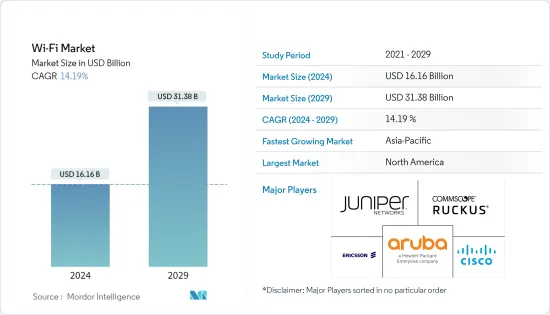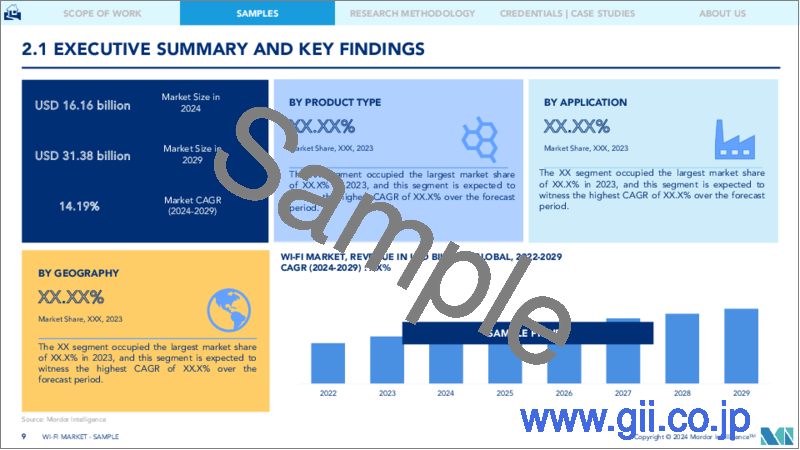|
|
市場調査レポート
商品コード
1445714
Wi-Fi:市場シェア分析、業界動向と統計、成長予測(2024~2029年)Wi-Fi - Market Share Analysis, Industry Trends & Statistics, Growth Forecasts (2024 - 2029) |
||||||
カスタマイズ可能
適宜更新あり
|
|||||||
| Wi-Fi:市場シェア分析、業界動向と統計、成長予測(2024~2029年) |
|
出版日: 2024年02月15日
発行: Mordor Intelligence
ページ情報: 英文 120 Pages
納期: 2~3営業日
|
- 全表示
- 概要
- 目次
Wi-Fi市場規模は2024年に161億6,000万米ドルと推定され、2029年までに313億8,000万米ドルに達すると予測されており、予測期間(2024年から2029年)中に14.19%のCAGRで成長します。

最近、在宅勤務がメガ動向になっています。大規模なリモートワークへの移行のスピードにより、携帯電話、ラップトップ、タブレット、デスクトップなどの個人用デバイスが使用されるようになりました。
主なハイライト
- 従業員が個人のWi-Fiインターネット接続を使用して企業ネットワークにアクセスしていることも観察されています。COVID-19のパンデミックによるこの予期せぬ混乱により、ビジネスや重要な機能の運営を維持するためのWi-Fiの使用が促進されました。さらに、世界中の複数の業界が、音声、ビデオ、IoTデバイスなどの帯域幅を大量に消費するアプリケーションに取り組むことで、COVID-19のパンデミックから立ち直りました。したがって、Wi-Fiの需要が高まると、ワイヤレスネットワークがオーバーサブスクライブになり、関連するITチームがアプリケーションのパフォーマンスを抑制するようになります。
- マシンツーマシンアプリケーションは、ますますワイヤレス接続に向けて推進されています。小売業と製造業向けの接続への複数の投資が成長に貢献しています。このような増加により、2.4 GHzおよび5 GHzのスペクトルで輻輳が生じ、6 GHzのスペクトル割り当ての需要が高まります。
- さらに、エッジネットワークとコンピューティングにより、エンタープライズアーキテクチャは、IoTアプリケーションと通信からのビジネスクリティカルなデータセット分析の処理を最適化するようになりました。ワークロードの50%以上が企業データセンターの外部で実行されます。これにより、5GとWi-Fi 6によって可能になるマルチアクセスエッジのおかげで、低遅延、リアルタイム通信、および高解像度ビデオアプリケーションの要件がさらに高まります。
- サービスの場合、制御デバイスの接続されたネットワークは、変換やIPベースの標準なしで相互に直接通信することが期待されます。ワイヤレス接続とコンピューティングプラットフォームを備えたこの統合アプローチにより、設計の革新が可能になる可能性があります。
- 国際電気通信連合(ITU)は、今年、世界人口の66%に相当する53億人がインターネットを利用すると推定しています。これは2019年から24%増加しており、この期間中に推定11億人がインターネットに参加したことになります。インターネットを利用する人が非常に多くなっているため、国内外のWi-Fiルーターメーカーは、市場で大きなシェアを獲得するために新製品を発表し、帯域幅を強化する機会が増えるでしょう。
- さらに、パブリックWi-Fiネットワーク(事前共有キーを持つネットワーク)は安全なオプションではありません。これらのネットワークは小売店とは異なる意図を持っている可能性がありますが、デバイスやデータを保護するための一定レベルの保証や法的義務がないことが脅威となります。繰り返しますが、ユーザーはインターセプトとデータの読み取りと変更が不可能であることを確認するために支援が必要です。
Wi-Fi市場の動向
屋内はかなりの市場シェアを占めると予想される
- Wi-Fiの人気は近年ますます高まっています。ローカルエリアネットワーク(LAN)は、配線やケーブルを使用せずに動作できるようになり、企業や家庭にとって好ましい選択肢となっています。 Wi-Fiは、ラップトップ、スマートフォン、タブレットコンピュータ、電子ゲーム機などの接続されたデバイスにワイヤレスブロードバンドインターネットアクセスを提供するためにも利用されています。
- さらに、GPSは通常壁によって遮られるテクノロジーであり、位置追跡のために建物内でより良好な受信を必要とします。これに対抗するために、Wi-Fiは、リアルタイムロケーションシステム(RTLS)の資産タグの位置を計算するための一般的なテクノロジーの選択肢として浮上しています。
- Wi-Fiは一般に動作範囲が短くなりますが、信号は最大150メートルまで延長できます。精度は通常、環境内に展開されているアクセスポイントの数によって決まります。エリア内のアクセスポイントの数は、正確で正確な位置情報の生成に直接比例します。 Wi-Fi測位システムでは、追加のハードウェアやインフラのメンテナンスは必要ありません。ほとんどのオフィススペース、家庭、その他の施設にはすでにWi-Fiインフラが設置されているため、追加投資なしで基本レベルの測位機能を提供することが可能です。
- さらに、Wi-Fi通話は屋内Wi-Fi設定のもう1つの主要なアプリケーションです。モバイル加入率の上昇により、携帯電話ネットワークはサービスを配信したり、近代的な建物に浸透したりすることが困難になっています。人々はほとんどのデータをWi-Fi経由で実行し始めています。
- さらに、音声通話は、SkypeなどのOTTアプリケーションの形式、またはフェムトセルやUMAなどの取り組みとしてWi-Fi経由で送信でき、ユーザーの自宅でのモバイル音声サービスの到達範囲を強化できます。さらに、国内通話と国際通話に同じ料金を請求するため、一般的なネットワーク料金に代わる魅力的な選択肢となっています。
- さらに、ほとんどの家庭は「スマートホーム」に変わりつつあり、多くの機能を利用するためにインターネットが必要になります。 Amazon EchoやGoogle Homeなどのスマート TVやスマートスピーカーの登場により、ワイヤレスルーター市場の成長が促進されました。
アジア太平洋が最も急速な成長を遂げる
- 中国には確立された5Gエコシステムがあり、予測期間中にさらに成長すると予想されます。ただし、5Gテクノロジーは現在のモバイルブロードバンドとともにホットスポットテクノロジーとして機能すると考えられており、その成長は緩やかなものになると予想されます。中国はアジア太平洋地域で最も広範な5Gネットワークを持っています。工業情報化省によると、中国は昨年60万以上の5G基地局を建設すると予想しています。
- 中国では、Wi-Fiは屋内用途にも広く使用されています。家電産業が好調なこの国では、予測期間中にWi-Fiの急速な普及が見込まれると予想されます。さらに、2020年 11月に、中国に本拠を置く企業ZTEは、6つのセットトップボックスを備えた初のWi-Fi、ZTE ZXV10 B860AV6を発売しました。これは、高い安定性と低遅延とともに高速インターネットアクセスを提供します。さらに、Wi-Fi 6伝送QoSソリューションと家全体のスマートネットワーキングソリューションをサポートします。
- さらに、日本政府はスマートシティ開発への投資促進を目指す取り組みに同意しました。国土管理省の発表によると、政府は先に、近代的な都市空間と都市管理を開発するためのITの利用を主に扱う「スマートシティ原則」に合意していました。これにより、カンボジアと日本の間に都市開発のための官民プラットフォームが効果的に構築されました。
- エアアジアは2022年11月、テクノロジー企業シュガーボックスとの提携を発表し、全航空機で機内Wi-Fiの提供を開始しました。このサービスにより、エアアジアインディア便を利用する旅行者は、1,000本を超える国際映画やインド映画、ウェブシリーズのエピソード、ショートムービーにアクセスし、機内に設置されたシステムからOTTアプリからバッファフリーのコンテンツをストリーミングできるようになります。
- さらに、2020年12月の最新情報によると、韓国は世界で初めて公共バス内に全国規模の無料無線インターネットネットワークを確立しました。これは、国民が情報に簡単にアクセスできるようにし、通信コストを削減するために行われました。また、韓国政府は公共エリアに無料Wi-Fiアクセスポイントを1万か所設置する計画です。今年までに、全国の交通機関の駅やコミュニティサービスセンターなどの公共の場所に合計4万1,000のアクセスポイントを設置したいと考えています。
Wi-Fi業界の概要
Wi-Fi市場は競争が激しく、複数の大手企業が存在します。市場で卓越したシェアを持つ大手企業は、海外への顧客ベースの拡大に注力しています。これらの企業は、市場シェアと収益性を向上させるために、戦略的な協力イニシアチブを活用しています。市場に参入している企業は、自社の製品機能を強化するために、無線ルーター技術に取り組む新興企業を買収することもあります。市場における最近の動向には次のようなものがあります。
2022年 11月、世界のIoTソリューションプロバイダーであるQuectel Wireless Solutionsは、QualcommのQCA206x Wi-Fi 6EチップをベースにしたWi-FiおよびBluetoothモジュールのFC6xEシリーズの発売を発表しました。 Wi-Fiをより高速、より安全、より信頼できるものにするために作られています。このシリーズにはBluetoothオーディオ機能もあります。
2022年 2月、コムスコープはボーダフォンドイツとの提携を発表し、Touchstone TG6442 DOCSIS 3.1ケーブルゲートウェイを展開し、ドイツ全土の何百万もの加入者にWi-Fi 6パフォーマンスを提供しました。この提携により、ボーダフォンドイツは顧客の家庭内Wi-Fi接続を強化し、より低い遅延でより高速なブロードバンド速度を提供できるようになり、Wi-Fiやその他の遅延に敏感なアプリケーション上で信頼性の高いUltra HDビデオを実現できるようになります。
その他の特典
- エクセル形式の市場予測(ME)シート
- 3か月のアナリストサポート
目次
第1章 イントロダクション
- 調査の前提条件と市場の定義
- 調査範囲
第2章 調査手法
第3章 エグゼクティブサマリー
第4章 市場洞察
- 市場概要
- 業界の魅力- ポーターのファイブフォース分析
- 供給企業の交渉力
- 買い手の交渉力
- 新規参入業者の脅威
- 代替品の脅威
- 競争企業間の敵対関係の激しさ
- 業界のバリューチェーン分析
- COVID-19がWi-Fi業界に与える影響(最近の労働環境の変化により、屋内Wi-Fi製品の需要が増加し、BYOD動向の影響も受けている)
- Wi-Fi規格と規制の進化
第5章 市場力学
- 市場促進要因
- 主要市場におけるスマート家電デバイスの需要の高まり
- 新興地域での屋外 Wi-Fiの導入に焦点を当てた進行中のスマートシティプロジェクト
- Wi-Fiテクノロジーにおける継続的な技術進歩(Wi-Fi 6標準の実装など)
- 市場の課題
- 厳格な政府ガイドラインとデータ規制
- 高密度環境における運用上の課題
- 屋外エリアでの導入に関する懸念
第6章 世界Wi-Fi市場 - セグメンテーション
- 製品タイプ別
- アクセスポイント
- ゲートウェイ
- ルーターとエクステンダー
- サービス(設計、実装、サポート)
- その他のデバイスタイプ
- その他のソリューション
- アプリケーションタイプ別
- 屋内(住宅、企業、教育)
- 屋外(公共サービス、輸送、公共施設など)
- 地域
- 北米
- 米国
- カナダ
- 欧州
- 英国
- ドイツ
- フランス
- その他欧州
- アジア太平洋
- 中国
- 日本
- 韓国
- その他アジア太平洋
- ラテンアメリカ
- 中東とアフリカ
- 北米
第7章 競合情勢
- 企業プロファイル
- Cisco Systems Inc.
- Aruba Networks(HP Enterprise)
- CommScope(Ruckus Networks(Arris International))
- Juniper Networks Inc.
- Telefonaktiebolaget LM Ericsson
- Huawei Technologies Co. Ltd
- Aerohive Networks(Extreme Networks)
- MetTel Inc.
- Cloud4Wi Inc.
- Fortinet Inc.
- Purple Wi-Fi Ltd
- SingTel
- Ubiquiti Inc.
- Motorola Solutions Inc.
- New H3C Technologies Co. Ltd
第8章 投資分析
第9章 市場の将来
The Wi-Fi Market size is estimated at USD 16.16 billion in 2024, and is expected to reach USD 31.38 billion by 2029, growing at a CAGR of 14.19% during the forecast period (2024-2029).

Working from home has become a megatrend these days. The speed of the shift to large-scale remote work has resulted in personal devices, including mobile phones, laptops, tablets, desktops, etc.
Key Highlights
- Employees are also observed using personal Wi-Fi internet connections to access the corporate network. This unexpected disruption due to the COVID-19 pandemic boosted the use of Wi-Fi to keep businesses and critical functions operational. Moreover, multiple industries globally bounced back from the COVID-19 pandemic by engaging in bandwidth-hungry applications, such as voice, video, and IoT devices. Therefore, as the demand for Wi-Fi increases, wireless networks become oversubscribed, leading the allied IT teams to throttle application performance.
- Machine-to-machine applications are increasingly driven toward wireless connections. Multiple investments in connectivity for retail and manufacturing are contributing to the growth. Such growth creates congestion in the 2.4 and 5 GHz spectrums, driving the demand for the 6 GHz spectrum allocation.
- Further, edge networks and computing have led enterprise architectures to optimize processing for business-critical analysis of data sets from IoT applications and communications. More than 50% of the workloads are performed outside the enterprise data center. This further boosts the requirement for low-latency, real-time communications, and high-definition video applications thanks to the multi-access edge enabled by 5G and Wi-Fi 6.
- For services, the connected networks of control devices are expected to communicate directly with each other without translation or IP-based standards. This integrated approach with wireless connectivity and compute platforms may enable design innovation.
- In the current year, the International Telecommunication Union (ITU) estimates that 5.3 billion people, or 66% of the world's population, will be utilizing the Internet. This represents a 24% increase from 2019, with an estimated 1.1 billion people joining the Internet during that time. With so many more people using the internet, both local and international Wi-Fi router makers will have more chances to come out with new products and boost bandwidth in order to get a big share of the market.
- Additionally, public Wi-Fi networks (those with a pre-shared key) do not represent a safe option. While these networks may have different intentions than retail stores, the absence of a level of assurance or legal obligation for them to secure a device or data poses a threat. Again, users need help to be sure of the intercept and their inability to read and modify their data.
WiFi Market Trends
Indoor is Expected to Account For Significant Market Share
- The popularity of Wi-Fi has invariably increased in recent years. Local area networks (LANs) can now operate without the use of wiring or cables, making them the preferred choice for businesses and homes. Wi-Fi has also been utilized to provide wireless broadband Internet access for connected devices, such as laptops, smartphones, tablet computers, and electronic gaming consoles.
- Further, GPS is a technology typically obstructed by walls and needs better reception inside buildings for location tracking. To counter this, Wi-Fi has emerged as a popular technology choice for calculating the position of an asset tag for a real-time location system (RTLS).
- Although Wi-Fi generally has shorter operation ranges, the signal can be extended up to 150 meters. The accuracy is typically determined by the number of access points deployed in the environment. The number of access points in the area is directly proportional to the production of a precise and accurate location. Wi-Fi positioning systems do not require additional hardware or infrastructure maintenance. Since most office spaces, homes, and other facilities already have Wi-Fi infrastructure installed, providing a base level of positioning capability is possible without additional investments.
- Moreover, Wi-Fi calling is another primary application in indoor Wi-Fi settings. Increasing mobile subscription rates have been causing cellular networks to face difficulties distributing their offerings and penetrating modern buildings; people have begun running most of their data through Wi-Fi.
- Further, voice calls can be transmitted over Wi-Fi either in the form of OTT applications such as Skype or as initiatives such as femtocells and UMA to enhance the reach of mobile voice services in users' homes. Moreover, charging the same rate for domestic and international calls has made it an attractive alternative to general network tariffs.
- Further, most households are being transformed into "smart homes," which require the internet to facilitate many functions. The advent of smart TVs and smart speakers, such as Amazon Echo and Google Home, boosted the growth of the wireless router market.
Asia-Pacific to Witness the Fastest Growth
- China has an established 5G ecosystem, which is expected to grow further in the forecast period. However, the 5G technology is likely to serve as a hotspot technology along with the current mobile broadband, and the growth is expected to be gradual. In the Asia-Pacific region, China has one of the most extensive 5G networks. According to the Ministry of Industry and Information Technology, China expected to build over 600,000 5G base stations last year.
- In China, wi-fi is also widely used for indoor applications. With its robust consumer electronics industry, the country is expected to witness the rapid adoption of wi-fi over the forecast period. Additionally, in November 2020, a China-based company, ZTE, launched its first wi-fi with six set-top boxes, the ZTE ZXV10 B860AV6, which offers high-speed internet access along with high stability and low latency. Additionally, it supports wi-fi 6 transmission QoS solutions and a smart networking solution for the whole house.
- Further, the Government of Japan agreed to an initiative that seeks to drive investments in the development of smart cities. According to an announcement by the Ministry of Land Management, the government had earlier agreed to "smart city principles," which deal primarily with the use of IT to develop modern urban spaces and urban management. This has effectively created a public-private platform for urban development between Cambodia and Japan.
- In November 2022, AirAsia announced its partnership with technology firm Sugarbox and started providing in-flight Wi-Fi on all its aircraft. The service will enable travelers on AirAsia India flights to access over 1,000 international and Indian movies, web series episodes, and short movies, and stream buffer-free content from OTT apps from the system installed in the flight.
- Furthermore, according to a December 2020 update, South Korea established a free nationwide wireless internet network on public buses for the first time in the world. This was done to give citizens easy access to information and reduce communication costs. Also, the South Korean government plans to install 10,000 free wi-fi access points in public areas. By this year, it hopes to have installed 41,000 access points in total at public locations across the country, such as transportation stations and community service centers.
WiFi Industry Overview
The Wi-Fi market is highly competitive, with several major players. The major players with prominent shares in the market focus on expanding their customer bases across foreign countries. These companies are leveraging strategic collaborative initiatives to increase their market share and profitability. The companies operating in the market also acquire start-ups working on wireless router technologies to strengthen their product capabilities. Some of the recent developments in the market are:
In November 2022, Quectel Wireless Solutions, a global IoT solutions provider, announced the launch of the FC6xE series of Wi-Fi and Bluetooth modules based on Qualcomm's QCA206x Wi-Fi 6E chip. It is made to make Wi-Fi faster, more secure, and more reliable. The series also has Bluetooth audio capabilities.
In February 2022, CommScope announced its partnership with Vodafone Germany to deploy its Touchstone TG6442 DOCSIS 3.1 cable gateways to deliver Wi-Fi 6 performance to millions of subscribers across Germany. The partnership would enable Vodafone Germany to enhance its customers' in-home Wi-Fi connections and offer faster broadband speeds with lower latency, enabling reliable ultra-HD video over Wi-Fi and other delay-sensitive applications.
Additional Benefits:
- The market estimate (ME) sheet in Excel format
- 3 months of analyst support
TABLE OF CONTENTS
1 INTRODUCTION
- 1.1 Study Assumptions and Market Definition
- 1.2 Scope of the Study
2 RESEARCH METHODOLOGY
3 EXECUTIVE SUMMARY
4 MARKET INSIGHT
- 4.1 Market Overview
- 4.2 Industry Attractiveness - Porter's Five Forces Analysis
- 4.2.1 Bargaining Power of Suppliers
- 4.2.2 Bargaining Power of Buyers
- 4.2.3 Threat of New Entrants
- 4.2.4 Threat of Substitutes
- 4.2.5 Intensity of Competitive Rivalry
- 4.3 Industry Value Chain Analysis
- 4.4 Impact of COVID-19 on the Wi-Fi Industry (Recent Changes in Work Environment has Led to Increasing Demand for Indoor Wi-Fi Products and the Impact of BYOD Trends)
- 4.5 Evolution of Wi-Fi Standards and Regulations
5 MARKET DYNAMICS
- 5.1 Market Drivers
- 5.1.1 Rise in Demand for Smart Consumer Electronics Devices in the Major Markets
- 5.1.2 Ongoing Smart City Projects Focused on Deployment of Outdoor Wi-Fi in Emerging Regions
- 5.1.3 Ongoing Technological Advancements in Wi-Fi Technology (Wi-Fi 6 Standard Implementation, Etc.)
- 5.2 Market Challenges
- 5.2.1 Stringent government guidelines and data regulations
- 5.2.2 Operational Challenges in Denser Environments
- 5.2.3 Concerns Related to Implementation in Outdoor Areas
6 GLOBAL WI-FI MARKET - SEGMENTATION
- 6.1 By Product Type
- 6.1.1 Access Points
- 6.1.2 Gateways
- 6.1.3 Routers and Extenders
- 6.1.4 Services (Design, Implementation, and Support)
- 6.1.5 Other Device Types
- 6.1.6 Other Solutions
- 6.2 By Application Type
- 6.2.1 Indoor (Residential, Enterprises, Education)
- 6.2.2 Outdoor (Public Services, Transportation, Public Utilities, Etc.)
- 6.3 Geography
- 6.3.1 North America
- 6.3.1.1 United States
- 6.3.1.2 Canada
- 6.3.2 Europe
- 6.3.2.1 United Kingdom
- 6.3.2.2 Germany
- 6.3.2.3 France
- 6.3.2.4 Rest of Europe
- 6.3.3 Asia Pacific
- 6.3.3.1 China
- 6.3.3.2 Japan
- 6.3.3.3 South Korea
- 6.3.3.4 Rest of Asia-Pacific
- 6.3.4 Latin America
- 6.3.5 Middle East and Africa
- 6.3.1 North America
7 COMPETITIVE LANDSCAPE
- 7.1 Company Profiles
- 7.1.1 Cisco Systems Inc.
- 7.1.2 Aruba Networks (HP Enterprise)
- 7.1.3 CommScope (Ruckus Networks (Arris International))
- 7.1.4 Juniper Networks Inc.
- 7.1.5 Telefonaktiebolaget LM Ericsson
- 7.1.6 Huawei Technologies Co. Ltd
- 7.1.7 Aerohive Networks (Extreme Networks)
- 7.1.8 MetTel Inc.
- 7.1.9 Cloud4Wi Inc.
- 7.1.10 Fortinet Inc.
- 7.1.11 Purple Wi-Fi Ltd
- 7.1.12 SingTel
- 7.1.13 Ubiquiti Inc.
- 7.1.14 Motorola Solutions Inc.
- 7.1.15 New H3C Technologies Co. Ltd






